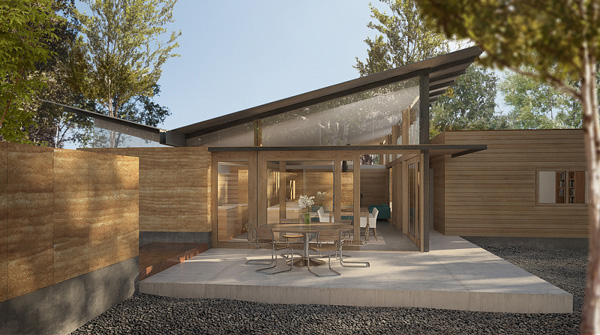
Designed by Pyatt Studio, Casa Sanitas is the first rammed earth house to be constructed in the city of Boulder, Colorado and incorporates an insulated rammed earth enclosure appropriate for the Colorado Front Range climate.

Architecture, Design, and Culture using of mud, clay, soil, dirt & dust.

Designed by Pyatt Studio, Casa Sanitas is the first rammed earth house to be constructed in the city of Boulder, Colorado and incorporates an insulated rammed earth enclosure appropriate for the Colorado Front Range climate.

Photo: Héctor Santos-Díez
Vier Arquitectos, comprised of Antonio Raya, Christopher Crespo, Santiago Sánchez and Enrique Antelo, are the designers a municipal swimming pool in Toro (Zamora), Spain. A unique quality of the facility is that its exterior walls have been constructed of rammed earth, a traditional technique updated on a contemporary building typology.
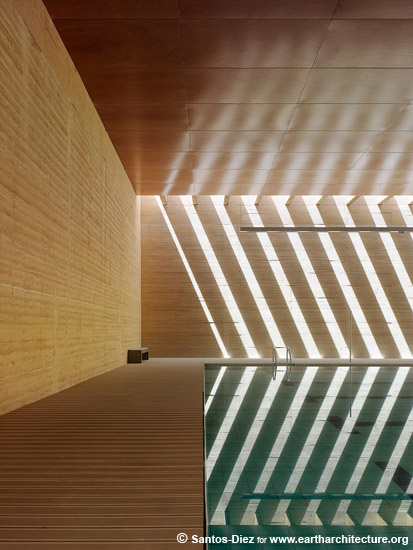
Photo: Héctor Santos-Díez
The building, comprising three volumes, two for dressing and one more for the pool’s, supporting thermal collectors used to heat the pool water and showers, and extra water from the cleaning process, which is stored in a reservoir and reused in irrigating the landscape.
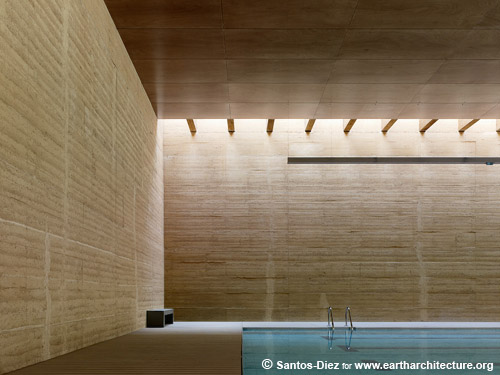
Photo: Héctor Santos-Díez
Low-energy materials were used throughout and the design for the pool received the first prize for ex eaquo de Edificación Sostenible in Castilla y Leon in its first edition.
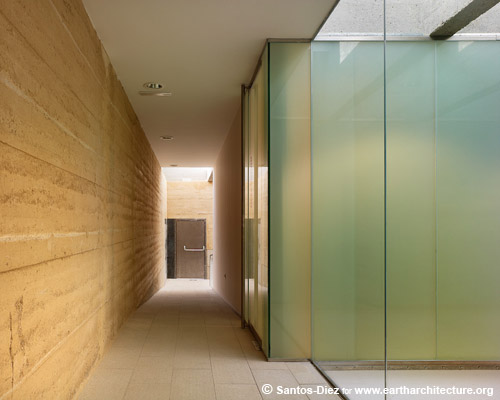
Photo: Héctor Santos-Díez
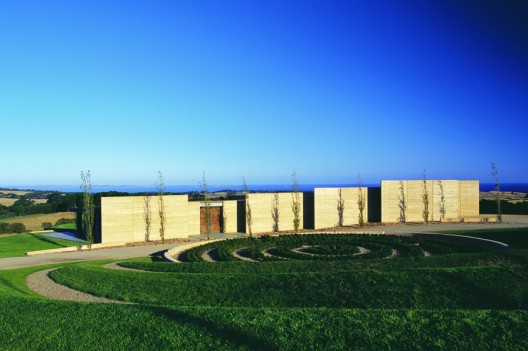
Constructed primarily in rammed earth using local Dromana crushed rock, the Earth House, designed by Jolson Architecture Interiors, is a 465 sqm 4 bedroom residence that seemingly rises from the landscape and cranks to capture the sweeping rural and coastal panoramic views.
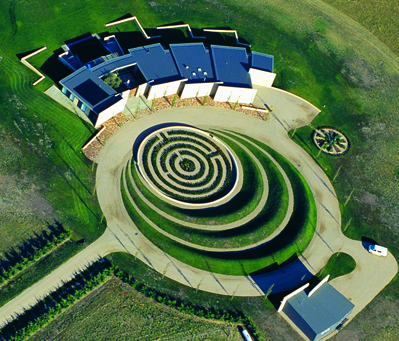
The western elevation consists of solid rammed earth walls without penetrations, designed as thermal banks capturing the afternoon sun. The eastern elevation is glazed to siphon dominant views inside. Designed around a large enclosed courtyard that provides protection from the strong winds, this outdoor room allows northern sunlight to filter into the main living areas.
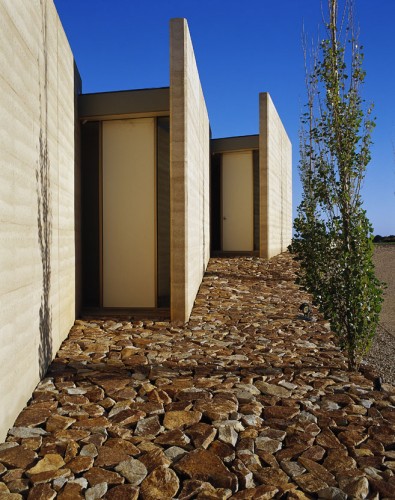
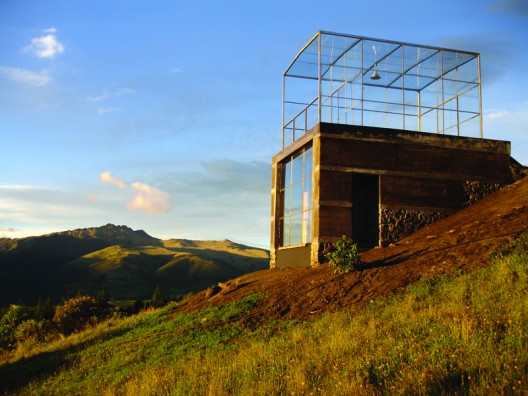
The Greenhouse Atelier, designed by al bordE, in Machachi, Ecuador is a shelter designed to express the powerful reflection of nature in the client’s paintings. The atelier is a “bubble” suspended between stone walls and rammed earth.

The existing space between walls, ground and bubble, protect the space from absorbing the humidity of the moorland. Additionally the first sun rays heat a radiator system that increase the temperature of the air gap. This heated air enters the space making it thermally comfortable. In the afternoon the main façade absorbs the sun heat, saving it in the solid floor of the workshop releasing the heat during the night.

Brittlebush is an experimental Desert Dwelling designed by Simón de Agüero, a recent graduate of the Frank Lloyd Wright School of Architecture in Taliesin, Arizona. The open-air living space incorporates tensile fabric structures into its design to shelter occupants from the sun. A fireplace provides winter heating.
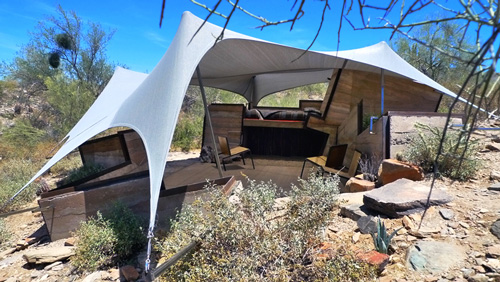
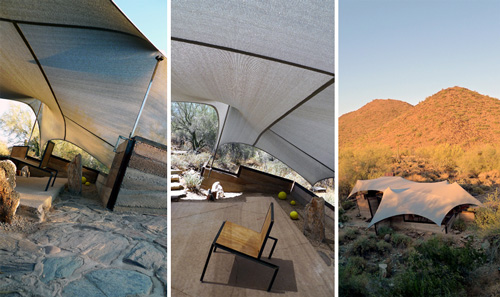
The majority of the material used for Brittlebush were recovered or found on site: 90% of the steel was salvaged from the school scrap yard, all of the wood used for the formwork was waste from a local renovation project, and the earth used for the walls was from on-site.

Read more at [ designboom | boiteaoutils | treehugger ]

Image: © Robert Horner
As the first rammed-earth construct in the City of Tacoma, The Tidal Resonance Chamber provides a contemplative and relaxation space for users of the Center for Urban Waters (a LEED Platinum Marine research and analysis facility) . Aimed at serving as an instrument for perceptual synchronize with the natural rhythms of Commencement Bay, the chamber’s thick insulated earthen walls buffer out the heavy industrial sounds of the surrounding Port of Tacoma, and through a series of feed back pump operations the chamber’s water level mirrors that of the Thea Foss Waterway manifesting as a ratio-reduction.

Image: © Robert Horner
Designed by Robert Horner, the Tidal Resonance Chamber’s main interior space has a trapezoidal footprint roughly 12’ x 18’. The fortified rammed-earth walls measure 8’6” in height, and rest atop a concrete foundation that measures 4’ in height. The chamber has a maximum filling capacity of 2500 gallons, which will fill at the highest of high tides. The interior of the chamber is filled with reclaimed granite curb fragments, river stones and will eventually populate with micro-organisms, barnacles and other aquatic lifeforms.
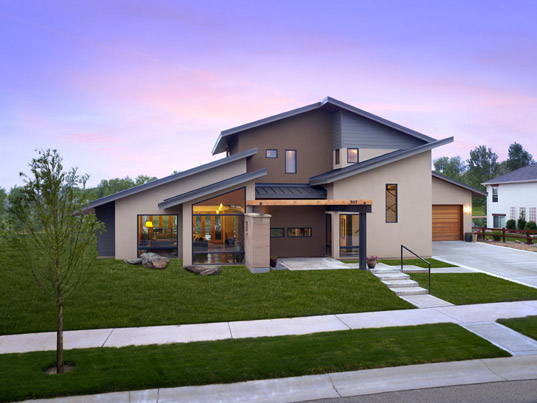
Michael and Lisa Eddy dreamt of living in a home that was designed to showcase their love of nature and appreciation for the environment around them in Colorado. Designed by JCL Architecture, their fantasy home made of rammed earth is characterized by a continuous trellis that greets you at the entry and leads you through the warmth of the house and out into the open backyard towards the landscape beyond. Aside from being beautiful, the house incorporates passive solar strategies and high thermal mass. Proper roof overhangs and southern exposure were calculated to allow maximum solar gain in the winter while minimizing heat gain in the summer. The thermal absorbent qualities of the rammed earth walls and dark stained concrete floors on both levels stabilize temperature swings from night to day and mitigate the need to run an air conditioning unit during the summer. These features are then further supported by a high-efficiency geothermal radiant floor heating system as well as soy-based insulation in the roof and walls.
[ inhabit ]
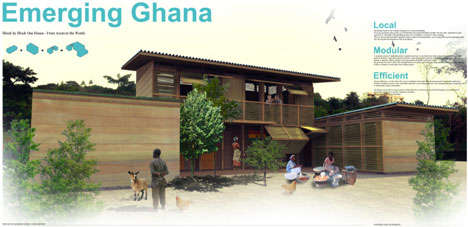
Enviu selected Emerging Ghana by Ana Morgado, João Caeiro, Lara Camilla Pinho, Maria de Paz Sequeira Braga and Maria de Carmo Caldeira, from Portugal, Mexico and Brazil, as the winner of the Open Source-House competition. The materials used are bamboo and dahoma, a local wood, for the modular and lightweight panels. These are held together with strong rammed earth walls. Due to the modular design, inside and outside spaces can be created depending on different needs and environments. Natural ventilation is archived throughout the building, due to the earth walls that keep the spaces cool and shaded areas.
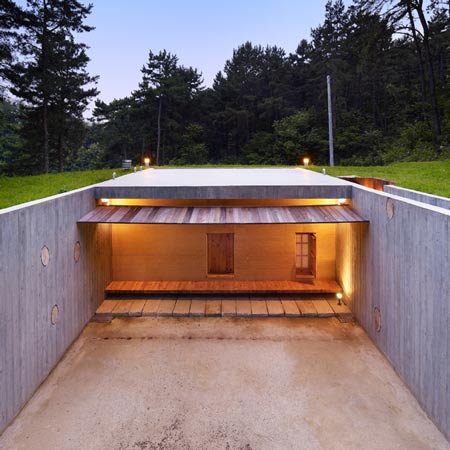
BCHO Architects have completed this house buried in the ground in Seoul, Korea to honour the late Korean poet Yoon Dong-joo.

The concrete-lined residence has two courtyards with earth floors, to which all rooms are connected.

The earth used for the walls is from the site excavation. Even though the viscosity of the existing earth was low, only minimal white cement and lime was used so the earth walls can return to the soil later.

Rammed Earth walls provide all the interior spatial divisions and the walls facing both courtyards.

Rammed-earth walls make use of the excavated earth while wood from a pine tree from the site is embedded in the concrete courtyard walls.
The groundbreaking survey Earth Architecture is now available in a paperback edition. Only a few copies of the hardcover collectors edition are still available, but going fast. Buy Earth Architecture if you live in the following countries::
[ U.S. | Japan | Germany
| U.K.
| France
| Canada
| Australia ]
Read what others say about Earth Architecture:
